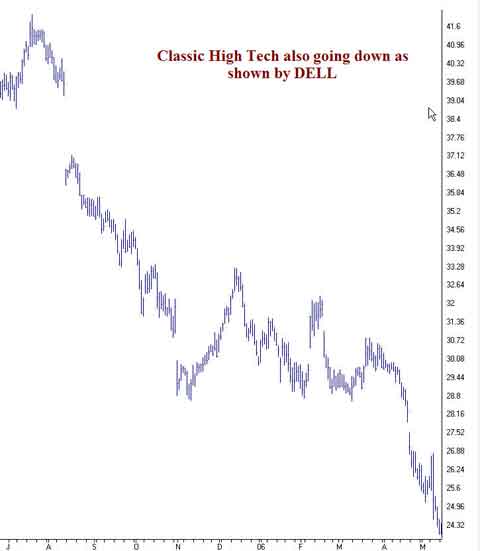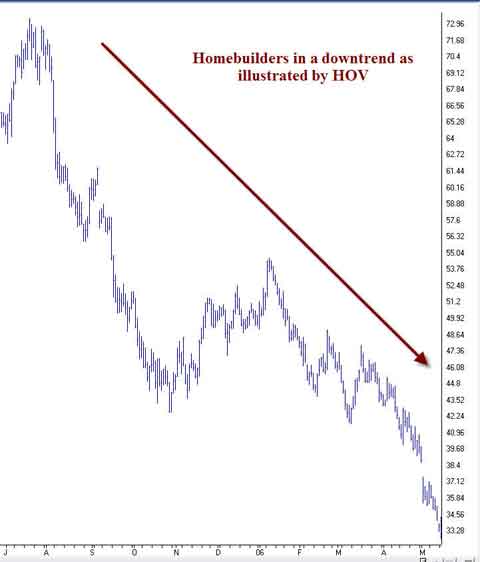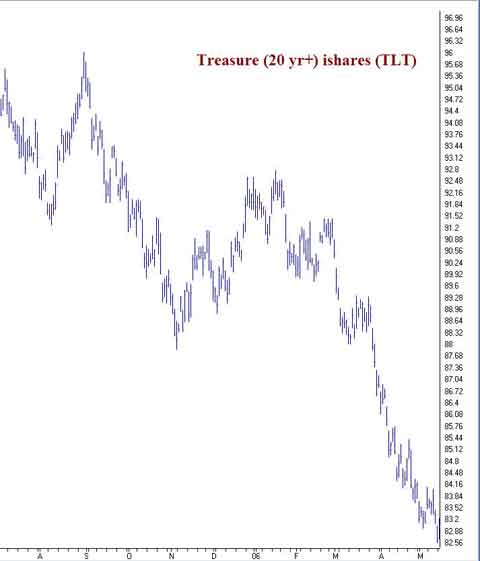|
||||||
Over the next few issues we'll be focusing on a back-to-the-basics series, which some you may have seen in our new site map. Whether this is the first time or the twentieth time that you have read this core information, it may just give you a new insight or could be a timely reminder. Both are useful. |
Risk and R-Multiples
Knowing when you�re going to exit a trade is the only way to determine how much you�re really risking in any given trade or investment. If you don�t know when you�re getting out, then in effect you�re risking 100% of your money ~Mel
Van says that risk is the amount of money you are WILLING TO LOSE if you are wrong about the market. So his definition of risk is how much you�ll lose per unit of your investment (i.e., share of stock or number of futures contracts) if you are wrong about the position that you have taken.
This is called the initial Risk or (R) for short.
One of the key principles for both trading and investing success is to always have an exit point when you enter a position. Trading without a pre-determined exit point is like driving across town and not stopping for red lights�you might get away with it a few times but sooner or later something nasty will happen.
In fact, the exit point that you have when you enter into a position is the whole basis for determining your risk, R, and the R-multiples (i.e., risk /reward ratios) of your profits and losses.
Your exit point can be either a percentage, in points or in dollar terms. For example, William O�Neal says that when you buy a stock, you should get out when it loses 7-8%. Another trader proposes a philosophy of getting out of a stock when it moves 1-2 points against you.
Tell me more about stops.
A stop is basically a preplanned exit. Van says that having stops prevents disaster even though this strongly goes against the grain of the long-term buy and hold philosophy.
When the price goes beyond your stop point, you exit the market. A trailing stop, basically adjusts that stop when the market moves in your favor, thus giving you a profit-taking exit as well.
For example, if you buy a stock at $30, and have a 25% stop, then you would exit the trade if the price drops 25% to $22.50.
In a trailing stop example, you buy the same stock at $30 (with the initial stop at $22.50) but if the stock moves up to $60, your 25% trailing stop would also move up with it and would be placed at 25% of $60, which is $45.
In other words, you would get out of the trade if the stock turned and dropped to $45.00 but because you bought it at $30, you would have locked in half your profit or $15. The trailing stop, in other words, moves the exit point in your favor as the price moves in your favor. BUT you must never move it backwards. Thus, if your stock moves down from $60 to $50, you would still keep your exit at $45, 25% away from the high of $60.
In Van�s opinion, this kind of stop is a safe form of buy-and-hold. You could be in a stock for a long time, but if something fundamental changes, it gets you out.
As an example, JDSU went from about $12 in February 1999 to a high of nearly $150 in 2000 (prices are adjusted for a number of share splits). A 25% stop would have kept you in the entire move. You would have been stopped out in April of 2000 at a substantial profit. However, if you had used a buy and hold philosophy, the same stock hit a low of $1.58 in October 2002. You might never get back to breakeven (an 800% gain from current prices) in your lifetime, but the stop would have totally allowed you to avoid that fall. In addition, it would have gotten you out of stocks like Enron and WorldCom before any of them became headlines.
There are many reasons for using tighter stops and you will probably need to use them for a variety of different trading styles. We are simply suggesting 25% stops as a substitute for the �buy and hold� philosophy.
We are not going to get any further into stops at this point because we want to get back to talking about risk. Just remember, you need to know when you are getting out of a position (your exit point or stop) to determine your risk.
Tell me more about Risk or (R).
Risk to most people seems to be an indefinable fear-based term. It is often equated with the probability of losing, or others might think being involved in futures or options is �risky.� Van�s definition is quite different to what many people think.
As far as Van is concerned, risk is definable.
Many people in the investment world are overly optimistic about the trades that they make. They don�t understand their worst case risk or even think about such factors.
Instead, people are seduced by trading terms such as �options,� �arbitrage,� and �naked puts.� Or, they buy into the academic definitions of risk such as volatility, which make for good theoretical articles by academicians, but they totally ignore two of the most significant factors in success. The golden rules of trading...
Never open a position in the market without knowing exactly where you will exit that position.
And
Cut your losses short and let your profits run.
So let�s look at the first golden rule in much more detail. That rule is to always have an exit point when you enter a position. The purpose of that exit point is to help you preserve your trading/investing capital. And that exit point defines your initial risk (1R) in a trade.
Let�s look at some examples.
Example 1:
You buy a stock at $50 and decide to sell it if it drops to $40. What�s your initial risk?
The initial risk is $10 per share. So in this case, 1R is equal to $10.
Example 2:
You buy the same stock at $50, but decide that you are wrong about the trade if it drops to $48. At $48 you�ll get out. What�s your initial risk?
In the second example, your initial risk is $2 per share, so 1R is equal to $2.
Example 3:
You want to do a foreign exchange trade, buying the dollar against the euro.
Let�s say that one hundred dollars is equal to 77 euros. The minimum unit you must invest is $10,000. You are going to sell if your investment drops down by $1000.
What�s your risk? What�s 1R?
We made this example sound complex, but it isn�t. If your minimum investment is $10,000 and you�d sell if it dropped $1000 to $9000, then your initial risk is $1000, and 1R is $1000.
R represents your initial risk per unit. R is simply the initial risk per share of stock or per futures contract or per minimum investment unit.
However, it�s not your total risk in the position because you might have multiple units.
What�s my total risk?
Your total risk would be based on your position sizing and how many shares or contracts that you actually buy.
For example, you may buy 100 of the shares in Example 1, which would be 100 multiplied by the share cost of $50 each. So your total COST would be $5000. But you are only willing to risk $10 per share. So $10 multiplied by 100 shares = $1000 total risk for this position.
In example 2, you also buy 100 shares at the $50 price for a total COST of $5000. However, in this scenario you are going to get out if it reaches $48. So your risk is $2 per share multiplied by the 100 shares - you are only risking $200 of your $5000 investment.
Understanding R-multiples
The next key point for you to understand is that all of your profits and losses should be related to your initial risk. You want your losses to be 1R or less. That means if you say you�ll get out of a stock when it drops $50 to $40, then you actually GET OUT when it drops to $40. If you get out when it drops to $30, then your loss is much bigger than 1R.
It�s twice what you were planning to lose or a 2R loss. And you want to avoid that possibility at all costs.
You want your profits to ideally be much bigger than 1R. For example, you buy a stock at $8 and plan to get out if it drops to $6, so that your initial 1R loss is $2 per share. You now make a profit of $20 per share. Since this is 10 times what you were planning to risk we call it a 10R profit.
You try it:
1. You buy a stock at $40 with a planned exit at $35. You sell it at $50. What�s your profit as an R-multiple?
2. You buy a stock at $60 and plan to get out if it drops to $55. However, when it goes that low, you don�t sell. Instead, you just stop looking at it and hope it will go back up. It doesn�t. It becomes part of the headline business news involving corporate scandal and eventually the stock becomes worthless. What�s your loss as an R-multiple?
3. You buy a stock at $50 and plan to sell it if it drops to $49. However, the stock takes off and jumps $20 in three weeks when you sell it. What is your profit as an R-multiple?
Answers
1. A 1R loss is $5. Your profit per share is $10, so you have a 2R profit.
2. A 1R loss is $5. Your loss per share is $60, so you have a 12R loss. Hopefully, you can understand why you never want to let this happen.
3. A 1R loss is $1. You profit per share is $20, so you have a 20R profit. And hopefully, you understand why you want this to happen all the time.
What's really interesting is that once you understand risk and portfolio management, you can design a trading system with almost any level of performance. For example, you can design a system to trade for clients that would make about 30% per year with only 10% draw downs.
On the other hand, if you want to trade your own account and be a little more risky, you can design a system that will produce a triple digit rate of return as long as you have enough money to do so and are willing to tolerate tremendous drawdowns.
It�s a whole new way of thinking for some, but most successful traders think in terms of risk/reward, which, of course, gives them an edge out there in the markets. Learning to trade and invest in this way will keep you in the game longer and enable you to run with your profits and cut your losses short. And what could be better than that?
About Van Tharp: Trading coach, and author Dr. Van K Tharp, is widely recognized for his best-selling book Trade Your Way to Financial Fre-edom and his outstanding Peak Performance Home Study program - a highly regarded classic that is suitable for all levels of traders and investors.
Van Tharp's
How to Develop a Winning Trading System That Fits You Home Study Program
This course will teach you how to use all the system building blocks to design a trading system in such a way that it fits your personality and style of trading or investing.
In the process of learning how to do this, you�ll probably come up with dozens of winning systems that will work because they�ll be based on criteria that fit your situation.
This audio series is about giving you the tools you need to design your own system.
The concepts and ideas you will learn could easily improve your trading overnight.
Learn More about this Home Study Program...
The Importance of a �Price Discipline�
by D. R. Barton, Jr.
�The price of excellence is discipline. The cost of mediocrity is disappointment.�
-- William Author Ward
My friend and great trader Tim V. talked ad infinitum about what he called his �price discipline.� I got the basic meaning at first, but it took me a little longer to understand the subtleties and power of this term.
You see, by price discipline, Tim meant much more than just having the restraint to stick to your buy and sell points. He was really talking about building a belief system or attributing a structure to the market. And there is real power in that.
If you don�t have a specific belief system about how the market works, your mindset and trading can get blown around by any wind that comes along, be it an ill wind or a favorable one.
A price discipline or structure that you believe in is so valuable because:
� It takes the �need to be right� away from you. It�s no longer you who is right or wrong about the position, it�s your price discipline. It�s much easier to get out of a position because the Gann Number / Elliott Wave count / moving average band was wrong than it is if it�s your idea and your position.
� Nothing is right every time. So finding the perfect market structure or price discipline is impossible. Finding one that is useful (meaning profitable) and fits you is much more important. Then you can stick with it in bad times and good ones.
� It gives you a framework for decision making. You can base a trading system on this framework. More sophisticated traders create a family of trading systems around their price discipline to take advantage of different time frames and other subtleties. And some people have such a well-defined market structure that it takes the place of a system in their trading. The folks that trade in this way are the most sophisticated traders that I know.
Next week, we�ll explore some of the more prevalent and useful price disciplines out there. There are very simple ones and some sophisticated ones. There are those that are mechanical and those that are subjective. Some of the ones that traders I know find most useful may surprise you! Until then�
Great Trading!
D. R.
D. R. Barton, Jr. is the Chief Operating Officer and Risk Manager for the Directional Research and Trading hedge fund group. D. R. has been actively involved in trading, researching, and teaching in the markets since 1986. D. R. has taught extensively in many investment areas including intra-day trading, swing trading, and cutting edge risk management techniques.
His writing credits include co-authoring Safe Strategies for Fin-ancial Fre-edom and co-creator and contributing author on Fin-ancial Fre-edom Through Electronic Day Trading.
D.R. presents the IITM Swing Trading Workshop and Professional Tactics for Day Traders Workshop. Each workshop is only held once each year.
Update to Market Efficiency
By the time you read this, I'll be on my way to Europe. The Peak Performance Course has been translated into German and they are holding a special event in my honor to celebrate and announce it.
Since I won't be back until the first of June, and the markets seem to be changing dramatically, I wanted to give you a brief update.
My efficiency model has now moved to 59.4% positive efficiency, which is quite a shift to the downside.
I still only have 32 stocks with negative efficiencies below minus ten, but most of those are starting to look like good shorting candidates. Some of the most interesting include my old favorite WON, TLT (long term treasuries), HOV (classic homebuilder), and DELL.
I've included graphs of the last three.
Note: Since I trade this strategy, I may or may not, have positions in the stocks that I mention. However, these examples are given for educational purposes and you should do your own due diligence if you decide to trade them.
Special Reports By Van Tharp
Click below to read page one of each report, or to order.
Do Not Reply to this email using the reply button as the email address is not monitored, your email will not be seen. Please click this link to contact us: [email protected]
The Van Tharp Institute does not support spamming in any way, shape or form. This is a subscription based newsletter.
If you no longer wish to subscribe, Unsubscribe Here
Or, paste this address in your browser: http://www.iitm.com/privacy_policy.htm
The Van Tharp Institute
102-A Commonwealth Court, Cary, NC 27511 USA
800-385-4486 * 919-466-0043 * Fax 919-466-0408
Copyright 2006 the International Institute of Trading Mastery, Inc.


